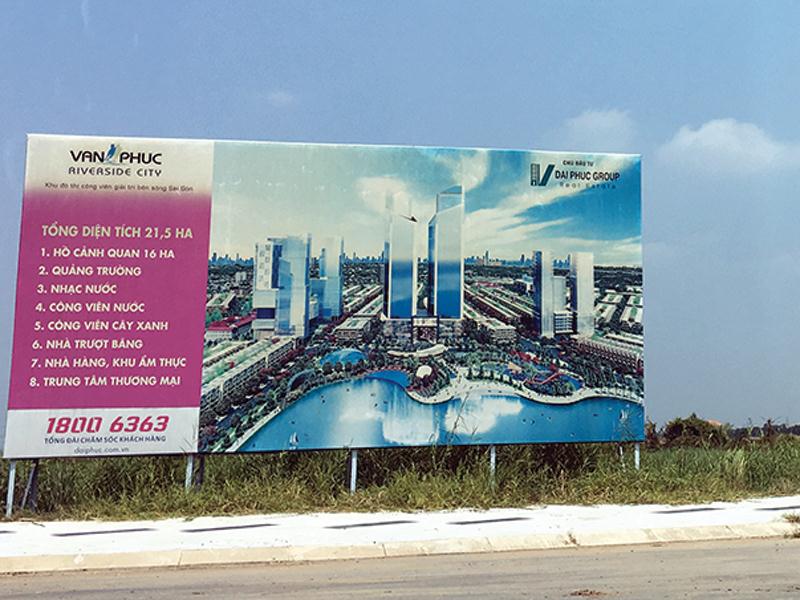Abnormalities around Van Phuc Riverside

| RELATED CONTENTS: | |
| List of Hanoi real estate projects coming under scrutiny | |
| M&A abuzz in real estate market | |
| M&A in real estate hikes early in year | |
| 60 real estate projects under investigation | |
Departure from initial investment purpose
There are a lot of complaints from people regarding the Van Phuc Riverside project (Thu Duc district). Therefore, in March 2017, a representative of the Ho Chi Minh City People’s Committee issued Document No.1233/VP, requesting the Ho Chi Minh City Inspectorate to inspect the project and report any violation it finds.
VIR found many abnormalities as early as the project planning.
Accordingly, in 1994, the city’s chief architect got the approval for the detailed planning of the cultural, leisure, sports, and golf centre in Hiep Binh Phuoc commune (Thu Duc district) on a total area of 200 hectares via Decision No. 4919/KTS-QH. However, the project was quickly forgotten.
In 2001, the Ho Chi Minh City People’s Committee assigned Saigon Investment-Construction and Real Estate Joint Stock Company (SCREC JSC) to implement a 5,084-square-metre-project of building houses for the staff of the Government Office via Decision No. 8237/QD-UB.
On January 20, 2004 Ho Chi Minh City issued Decision No.256/QD-UB with an aim to collect 177.7ha of land (including the 5,084sq.m set aside for the Government Office housing project) and assigned District 6 Economic Development and Construction Company to build the technical infrastructure of Hiep Binh Phuoc urban area on 198.5ha. After constructing the technical infrastructure, District 6 Economic Development and Construction Company had to hand over the entire area to the city to allocate and lease out for component projects.
Decision No.256/QD-UB also requested District 6 Economic Development and Construction Company to take responsibility for investment capital and the effectiveness of the project.
Contradictory decisions
Right after that, the Thu Duc People’s Committee issued Decision No.184/QD-UB dated March 17, 2004 on relocating households, agencies, companies and supporting the compensation for the damages caused by the main infrastructure construction project of Hiep Binh Phuoc urban area. In March 2004, the Board of Compensation was established and the compensation and resettlement plans of the project were approved.
Surprisingly, the plan of compensation and resettlement outlined in No.1500/PABT dated October 18, 2004 specified the investment capital of this project as follows: “The estimated compensation cost is nearly VND358 billion ($17 million). The investment capital shall be contributed by enterprises participating in component projects, who will contribute a sum equivalent to the total cost of construction of the main technical infrastructure.”
According to lawyer Tran Duc Phuong of the Ho Chi Minh City Bar Association, this compensation scheme is completely contrary to Decision No.256/QD-UB on capital mobilisation to implement the project. The District 6 Construction and Economic Development seems to be the unit representing other companies wishing to invest in component projects.
On the other hand, Decision No.256/QD-UB which assigned 198.5ha of land to District 6 Economic Development and Construction Company to invest in building the main technical infrastructure of Hiep Binh Phuoc urban area. The location and the boundaries of the land plot are determined according to the 1/2,000 map established by Do Dac Kien Thiet Company Limited (DOKICO Ltd.) on January 14, 2002.
DOKICO Ltd. built this map subject to a request from the enterprises implementing the component projects in the urban area. The measurements were not done by state agencies.
Only one month later, the Ho Chi Minh City People’s Committee issued six decisions to assign six component projects to companies including: District 1 Producing Import Export Trading and Service Joint Stock Company (Fimexco), Dong Nam Housing Business and Investment Corporation, Dai Nhan Housing Business Investment Corporation, District 6 Construction and Economic Development Company, and Housing and Urban Development Corporation.
“According to current regulations, for new urban area or urban projects (in which the state retrieves the land of the projects for public interest and economic development), the assignment and implementation process of the project is determined by the source of capital. In case the project is implemented by the state’s investment capital, the state will pay compensation for the land, then select the main investor and collect money from the component projects.”
“If the investment capital comes from enterprises, these enterprises will implement the project in a BT format (build-transfer) and they will be assigned part of the land area in the project (component project) or land elsewhere to recover their investment. However, the selection of the master project investor must be made public in accordance with the law,” said lawyer Phuong.
To be updated
What the stars mean:
★ Poor ★ ★ Promising ★★★ Good ★★★★ Very good ★★★★★ Exceptional
Latest News
More News
- JustCo expands business into Vietnam (December 22, 2025 | 17:58)
- Sun Group breaks ground on $2 billion Van Don casino complex (December 19, 2025 | 18:14)
- Rare, beautiful, sustainable: the mark of iconic real estate (December 19, 2025 | 08:00)
- Owner-occupied housing stabilises, paving the way for new growth cycle (December 18, 2025 | 17:04)
- Unlocking urban potential of smart cities (December 18, 2025 | 16:50)
- Green finance offers 'passport' for Vietnamese construction, building materials firms (December 15, 2025 | 08:00)
- Gamuda Land commit long-term investment (December 12, 2025 | 11:49)
- HITC ties up with Evolution to develop AI and hyperscale data centres in Vietnam (December 11, 2025 | 12:09)
- Real estate deals boom via high-profile names (December 08, 2025 | 11:32)
- Industrial segment shaped by M&As (December 08, 2025 | 08:00)

















 Mobile Version
Mobile Version